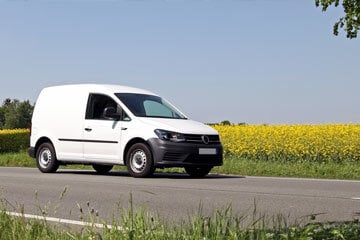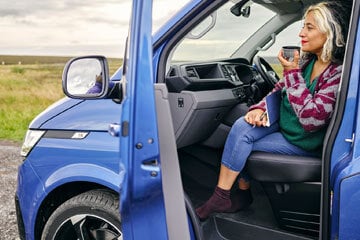Thinking about becoming a lorry driver? You'll need an HGV licence - and to get that, there's a 4-part CPC test to get through first.
With driver demand high, there are even ways to train for free!
Here's how it all works.

Getting a HGV provisional licence
Before you can take a lorry out on the road, you'll need a provisional licence. It's the first step in getting qualified, and it's simpler than you might think.
First, check you're eligible:
- You need to be 18 or over
- And already have a full car driving licence
There are a few different types of heavy vehicle licence depending on what you want to drive. So, make sure you know which one you're going for before you apply.
- D2 - the application form
- D4 - the medical form, filled in by your GP or a private medical provider
A few health things to bear in mind:
- Some medical conditions need to be declared to the DVLA
- If you're insulin-dependent, you'll need to prove you're managing it well
- You'll also need a medical check every year
Once you've got your forms filled in, send them off to the DVLA. There's no fee for the licence, but your GP might charge for completing the medical bit.
How long does it take to get a provisional HGV licence?
It should take around 3 weeks to get your provisional HGV licence. But it may take longer if any of your personal or health details need to be checked.
Basically: don't leave it to the last minute.
What does the CPC test involve?
The CPC test consists of 4 parts:
- Theory
- Case studies
- Driving ability
- Practical exam
You need to pass all of these to get the full CPC unless you have ‘acquired rights’ because of your existing driving experience.
Driver CPC part 1: Theory test
The first step in the CPC is the theory test, and it's split into 2 parts.
- Multiple choice
- Hazard perception
You'll book them separately, but you can take them both on the same day if you like. You'll need to pass both within 2 years to get your Part 1 theory certificate.
Multiple choice
You get 1 hour and 55 minutes to answer 100 multiple choice questions. The pass mark is 85/100 - so you've got a bit of breathing room.
Hazard perception
You have 19 videos to watch during the hazard perception test that contain 20 developing hazards. Out of these videos, 18 should include 1 hazard each. But 1 video will contain 2 hazards - so keep your eyes peeled.
The pass mark is 67/100.
Once you've passed both parts, you'll get your theory certificate. You'll need this when you book your Part 3 driving test.
And just a heads up: the certificate is only valid for 2 years from the date you pass the first part - so don't leave it too long to move on to the next stage.
Driver CPC part 2: Case studies
You only need to take this part of the test if you're going to be driving HGVs for a living. You can book the CPC part 2 case studies test as soon as you’ve got your HGV provisional licence.
This assessment contains 7 case studies based on situations you’re likely to come across while driving a large vehicle. You can find practice tests for this module free online.
You get 1 hour and 15 minutes to answer 6 to 8 multiple choice questions on each case study. The pass mark is 40/50.
Your pass letter should contain a reference number that you need to book part 4 of the CPC. The pass letter is valid for 2 years.
Driver CPC part 3: Driving ability test
Part 3 is all about what you can do behind the wheel. It lasts around 1 hour and 30 minutes and includes:
- Vehicle safety questions
- Practical road driving
- Off-road exercises
- Vehicle safety questions
Like a car driving test, expect to be asked some ‘show me, tell me’ questions such as:
- Show me what instrument checks you’d make before and after starting the engine on this vehicle
- Tell me how you’d check if the condition of the body is safe on this vehicle
GOV.UK has a full list of these questions - it might be worth having a look before your test.
Practical road driving
During your practical road driving test the examiner scores you on how you:
- Use the vehicle controls
- Move away at an angle, uphill and downhill
- Do a controlled stop
- Use the mirrors
- Give appropriate signals
- Show awareness and anticipation of other road users’ intentions
- Manage your progress and control your vehicle speed
- Deal with hazards
- Select a safe place to stop
There’s also a 10-minute section for independent driving.
Off-road exercises
The off-road exercises include an S-shaped reverse into a bay.
Passing the test
You pass your test if you have 15 or fewer driving faults and no dangerous faults.
Driver CPC part 4: Practical demonstration
Like part 2, you only need to take this part of the test if you plan to drive for a living.
This part checks how you'd handle real-life situations, not just driving itself. Your examiner will test your ability to:
- Load the vehicle safely and keep it secure
- Stop trafficking in illegal immigrants
- Assess emergency situations
- Reduce physical risks to yourself or others
- Do a walkaround vehicle safety check
Questions are based on the CPC syllabus. There should be 5 topics each with a maximum of 20 points. To pass, you must score at least 15/20 in each section and have an overall score of at least 80/100.
What type of HGV licence should I get?
The type of HGV licence you should get depends on the size of the vehicle you need to drive and what it carries. The different categories include:
- Class 1: This may also be referred to as C+E. This is for vehicles weighing more than 7.5 tonnes with a detachable trailer. These lorries are often used on longer routes.
- Class 2: Also called a category C licence, this is for vehicles weighing more than 7.5 tonnes with a rigid base. Fire engines and bin lorries fall into this category and are most commonly driven around towns and cities.
- Category C1: For smaller vehicles weighing between 3.5 and 7.5 tonnes. If you passed your driving test before 1997 you should automatically have one of these licences.
- Category D: You need this type of licence if you’re driving passengers in a HGV, for example a bus or a coach.
- Lorry Loader: This type of licence also permits you to use lorry loaders or hydraulic attachments to put items onto a long bed.
- Accord Dangereux Routier (ADR): You might need it if you have to transport dangerous goods, like fuel or other flammable liquids.
What happens if I fail any of the CPC tests?
There are 4 parts to the CPC test, and if you fail one, no worries - you can rebook it right away. You'll just need to wait at least 3 working days before taking it again.
What happens when I pass the CPC?
Once you pass, you'll get a Driver CPC card - also called a driver qualification card (or DQC, if you like acronyms).
You'll need to carry this with you when driving professionally. If you're still waiting for it to arrive and drive, you could be fined £50 if you're caught.
If you only take parts 1 and 3 of the CPC (meaning you skip the rest), your licence will be marked with code 101. That means you're only licensed to drive recreationally, not for work.
How long is a HGV licence valid for?
Your HGV licence is valid for 5 years at a time. To keep it active, you'll need to do 35 hours of periodic training within each 5-year period.
Once you hit 65, you'll need to renew your licence every year.
How much does it cost to get a HGV licence?
While it costs nothing for the provisional licence, there are costs for each stage of the Driver CPC.
| Stage of driver CPC | Cost |
|---|---|
|
Driver CPC part 1- theory- multiple choice
|
£26
|
|
Driver CPC part 1 - theory - (hazard perception)
|
£11
|
|
Driver CPC part 2 - case studies
|
£23
|
|
Driver CPC part 3a - off road exercises
|
£40
|
|
Driver CPC part 3b - on road driving
|
£115-£141
|
|
Driver CPC part 4 - practical demonstration
|
£55-£63
|
|
Total cost
|
£270
|
Add to this the cost of getting your driving up to the standard required for the test and any costs associated with medical tests.
How to get a HGV licence for free
Because of the ongoing shortage of lorry drivers, some companies might cover the cost of your HGV training. In return, you'll usually need to stick with them for a set amount of time - often around 2 years.
Another option is to do an apprenticeship in large goods while driving. These typically last 12-13 months, and you'll work towards your HGV licence as part of the course.
There are also specific bus and coach driver courses that are designed to address the shortages in these areas too. You can find more info on the official government website.
What can I drive without a HGV licence?
If you've passed your car test in 1996 or earlier, you can usually drive a van weighing up to 8,250kg MAM (maximum authorised mass) without needing a HGV licence. That's the vehicle's weight fully loaded - people, fuel and whatever you're carrying.
But, if you plan to drive a 7.5 - tonne van for work, you'll still need to take the CPC.
If you passed in 1997 or later, your limit is likely to be 3,500kg MAM - so anything heavier would require a HGC licence.
Visit our specialist truck insurance provider Quote Me Today for a quote
Get a quoteOr call 01227 285564 to speak to a member of their team







